Approaching a Total of Four Million People―Who Learns Japanese Language in the World?
The Japan Foundation
Began in 1974, the Japan Foundation has been conducting every few years a survey of overseas organizations offering Japanese-language courses, with the purpose of obtaining an accurate picture of the current state of Japanese-language education around the world. And this time, a survey targeting 203 countries was carried out in fiscal year 2012, and the "Survey Report on Japanese-Language Education Abroad 2012" has been recently published.
The spread throughout the countries: Japanese language learned in 136 countries worldwide
The fiscal 2012 survey established that Japanese-language education was offered in 128 countries and 8 areas, amounting to a total of 136 countries. This represented an increase of 3 countries compared to the fiscal 2009 survey's result of 125 countries and 8 areas, amounting to a total of 133 countries.
The total number of learners was approximately 3.99 million
The numbers of learners, institutions, and teachers all increased. There were 3,985,669 learners (up 9.2% compared to fiscal 2009); 16,046 institutions (up 7.5%); and 63,805 teachers (up 28.1%).

Provision of Japanese-language education was confirmed in 136 countries worldwide; the total number of learners was approximately 3.99 million.
The survey specifically targeted schools and other institutions teaching Japanese. The results therefore exclude lessons or courses aimed primarily at promoting international goodwill or intercultural exchange where Japanese is not taught as a language. They also exclude learners studying Japanese alone using television, radio, books, magazines, the Internet, or other methods. Bearing this in mind, the actual number of people studying Japanese must be considerably greater than the figures given here.
Over the past 33 years, the number of learners increased 31.3 times
During the 33 years between 1979 and 2012, Japanese-language education overseas increased continuously, resulting in significant expansion. During that time, ten surveys were conducted, and they reveal that the number of institutions increased 14-fold, from 1,145 to 16,046; the number of teachers increased 15.6 times from 4,097 to 63,805; and the number of learners increased 31.3 times from 127,167 to 3,985,669.
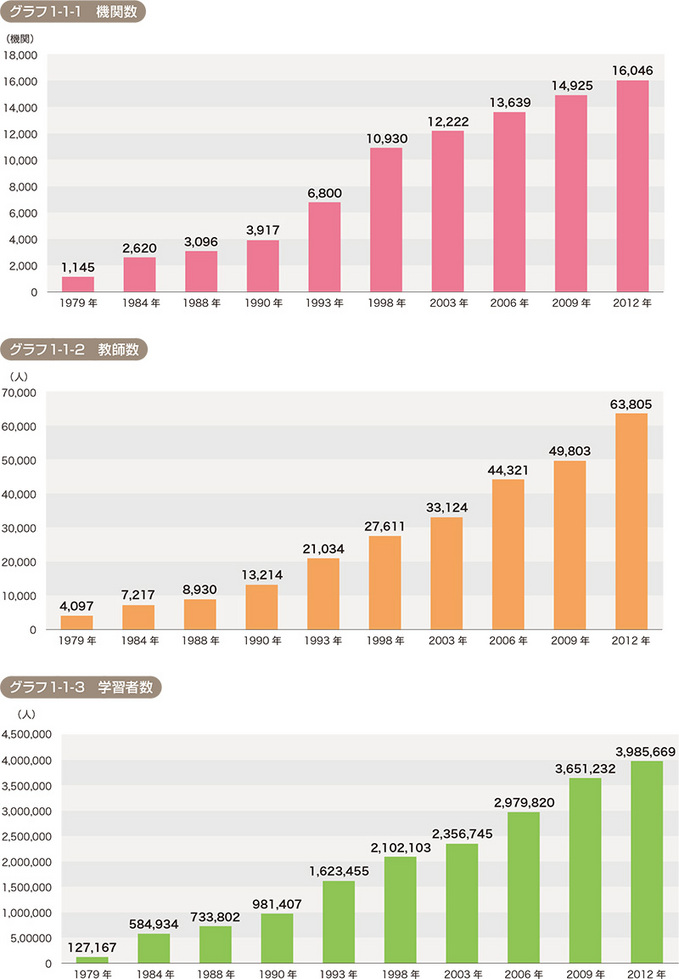
Over the past 33 years there was a 14-fold increase in the number of institutions, while the number of teachers increased 15.6 times, and the number of learners increased 31.3 times.
Why study Japanese language?
Among the reasons and purposes for Japanese-language study, the most frequently cited (multiple choices allowed) were:
1. Interest in Japanese language (62.2%)
2. Communication in Japanese (55.5%)
3. Interest in manga, anime, J-Pop, etc. (54.0%)
4. Interest in history, literature, etc. (49.7%)
5. Future employment (42.3%)
6. Institution's policy (35.3%))
7. Study in Japan (34.0%)
8. Understanding other cultures (32.4%)
9. Sightseeing in Japan (28.6%)
10. Examinations (university, etc.) (26.6%)
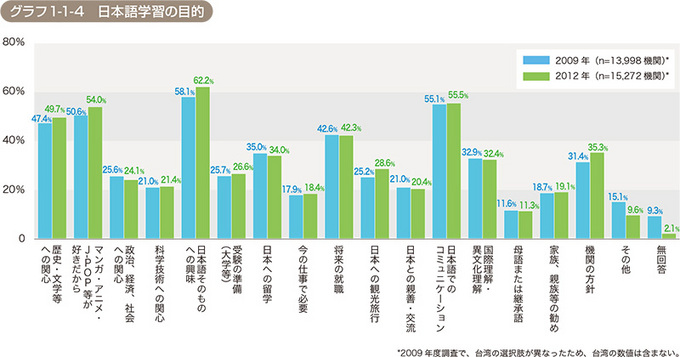
Among the reasons and purposes for Japanese-language study, "interest in Japanese language" was the most frequently cited (62.2%). The next most frequently cited were "communication in Japanese" (55.5%) and "interest in manga, anime, J-Pop, etc." (54.0%).
Overall, interest in acquiring knowledge about Japan was more prevalent than utility-based motivations. The fact that "interest in manga, anime, J-Pop, etc." was more frequently cited than "interest in history, literature, etc." makes it clear that Japanese pop culture has made its mark throughout the world, establishing itself as a starting point for interest in and involvement with Japan and the Japanese language. Also, it has become easier to access pop culture and other forms of Japanese culture from anywhere in the world, whether through traditional mass media or, in recent years, through the Internet, and this may have lent momentum to the trend. "Institution's policy" in sixth place refers to a circumstance where Japanese-language education is provided in line with the school principals and administrative agencies, aside from whether or not learners want to study the subject. It is, for example, represented by a situation where the subject is taught as a second foreign language in a high school.
Japanese-language education flourishes in East Asia and Southeast Asia
If numbers of institutions, teachers, and learners worldwide are compared by region, East Asia accounted for by far the highest percentages of the worldwide total on all three counts, followed by Southeast Asia. The other regions each accounted for approximately 10% or less of the worldwide totals for institutions, teachers, and learners. In terms of learner distribution, East Asia accounted for 54.1% of the total, or 2,154,344 learners, while Southeast Asia accounted for 28.4% of the total, or 1,132,701 learners. These two regions together therefore accounted for 82.5% of all learners.
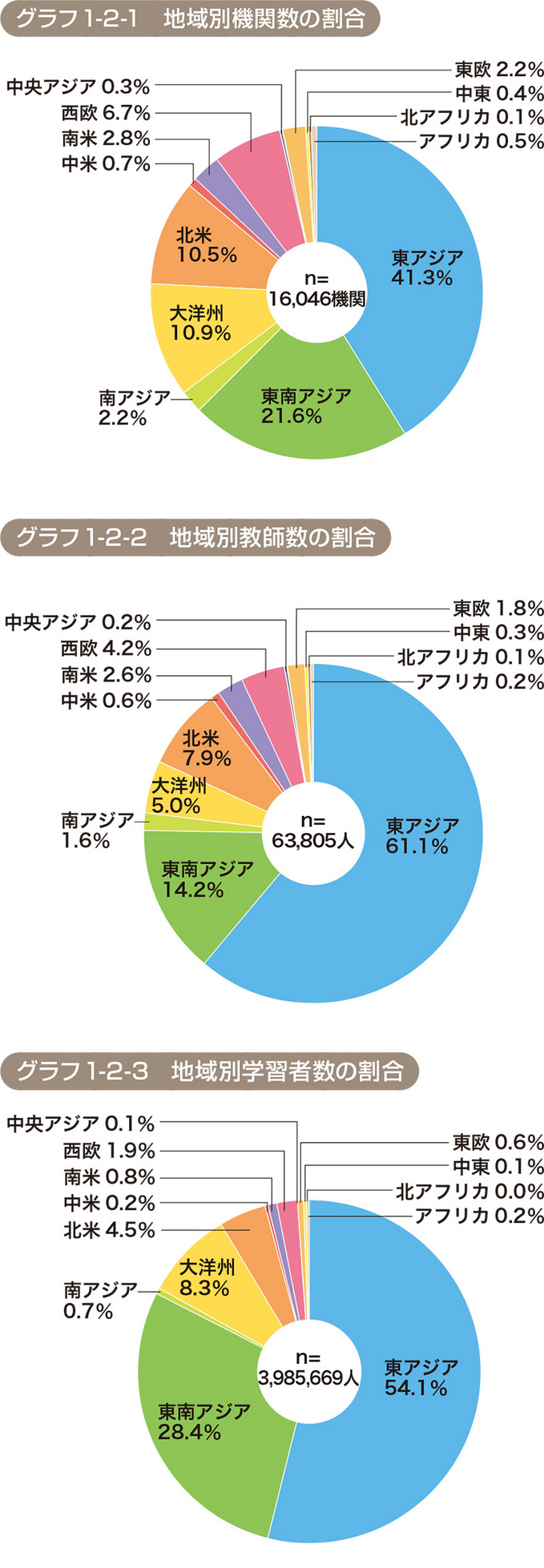
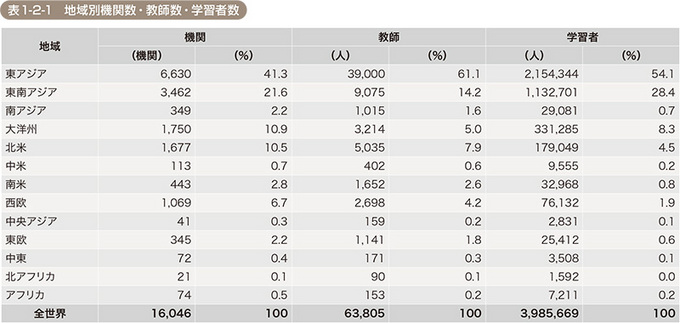
East Asia and Southeast Asia accounted for 62.9% of institutions, 75.3% of teachers, and 82.5% of learners.
The top three countries: China, Indonesia, and Korea
The country with more learners than anywhere else in the world was China with 1,046,490 learners. It was followed by Indonesia with 872,411; Korea with 840,187; Australia with 296,672; Taiwan with 233,417; the United States of America with 155,939; and Thailand with 129,616. Each of these seven countries was with 100,000 or more learners. There were also 13 countries with between 10,000 and 99,999 learners, as well as 33 countries with between 1,000 and 9,999 learners.
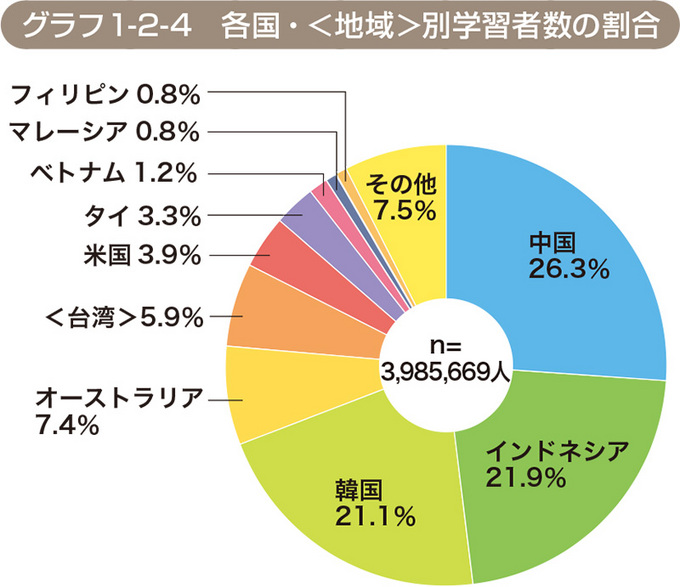 China accounted for 26.3% of all learners, Indonesia for 21.9%, and Korea for 21.1%. The three countries together accounted for almost 70% of the worldwide learner total.
China accounted for 26.3% of all learners, Indonesia for 21.9%, and Korea for 21.1%. The three countries together accounted for almost 70% of the worldwide learner total.
In addition to the above figures, the distribution in percentages also showed a high degree of concentration in specific countries within each region. The top three countries accounted for 69.2% of the total number of learners, while the top five countries accounted for 82.5%, and the top ten countries accounted for 92.5%. China, Indonesia, and Korea all exerted a particularly strong influence on the overall worldwide results (including results by level of education, reasons and purposes for Japanese-language study, and problems and concerns in Japanese-language teaching).

The problem or concern with regard to Japanese-language teaching: inadequate teaching materials
The problem or concern with regard to Japanese-language teaching cited by the highest number of institutions was "inadequate teaching materials" (28.5%), followed by "insufficient interest among learners" (26.5%), "inadequate facilities and equipment" (26.1%), "inadequate information on teaching materials and methods" (23.9%), and "declining number of learners" (21.0%). In comparison with the fiscal 2009 survey "other language(s) introduced / abolition of Japanese under consideration" increased from 6.8% to 8.6%, "declining number of learners" increased from 16.6% to 21.0%, and "insufficient interest among learners" increased from 23.3% to 26.5%. However, the other options were all cited less frequently than in 2009, indicating that circumstances are gradually becoming more favorable for Japanese-language education.
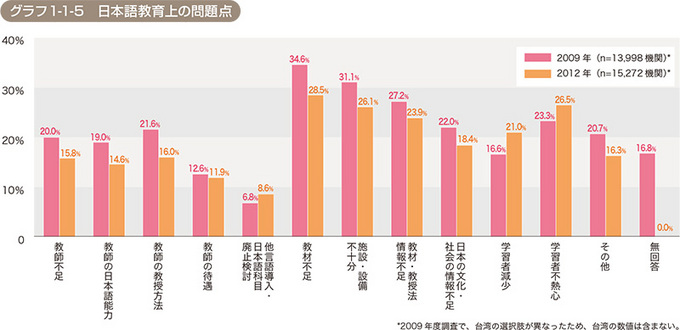
Among problems and concerns in Japanese-language teaching, the most commonly selected response was "inadequate teaching materials" (28.5%). The next most common was "insufficient interest among learners" (26.5%).
Problems and concerns with regard to Japanese-language teaching differ substantially according to region. Problems relating to resources such as teaching materials, teachers, and equipment were high in regions where Japanese-language education has expanded rapidly (such as Southeast Asia), as well as in regions where there is still very little provision (such as South Asia, Central America, North Africa, and Africa). Conversely, in regions with long histories of teaching Japanese, such as Western Europe and Pacific, almost all problems and concerns showed low response rates. In Southeast Asia, however, the item "insufficient interest among learners" elicited a particularly large number of responses. This is attributable to the fact that introduction of Japanese-language teaching at the secondary education level had expanded rapidly as a result of educational institutions' policies in this region. That is to say, with each country's education policy, the total number of Japanese-language learners increased, but it also created a circumstance of "insufficient interest among learners," particularly those who were not interested in the subject that much. Thus, this problem can be said to be one of the outcomes of "institution's policy," which has been mentioned earlier as a reason or purpose for the study. Having had the growing number of Japanese-language learners at secondary education institutions (including high schools) in various different countries, it should be necessary in the future to tackle such challenges as to develop and provide teaching materials that meet these learners' needs, as well as to maintain and improve the quality of teachers.
Note: In the Graph 1-2-4 and Table 1-2-2, an area is marked with an asterisk (*). For convenience's sake, references to "countries" in this article also include areas.
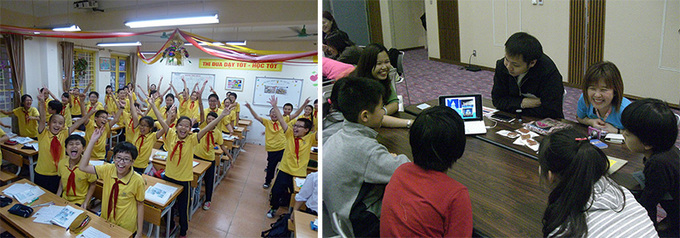
(left) Junior high school students studying Japanese language in Vietnam
(right) A Short-Term Training Program for Foreign Teachers of the Japanese-language; an exchange activity for elementary school students
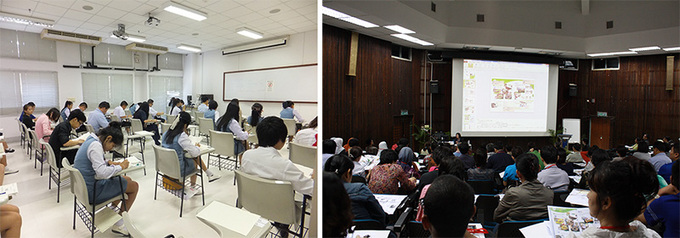
(left) Taking the Japanese-Language Proficiency Test in Bangkok
(right) A seminar on Japanese-language education, held in Malaysia

Japanese-language education in the U.S.
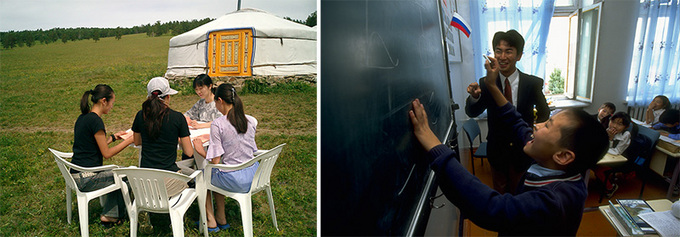
Japanese-language education in Mongolia
About the "Survey on Japanese-Language Education Abroad 2012"
Purpose
The purpose of the survey was to gain an understanding of the current status of Japanese-language education and to provide material that would be of use primarily for the following three purposes:
i. As supporting data for researchers and others conducting studies or research relating to Japanese-language education;
ii. As reference materials for organizations involved in Japanese-language education, international exchange groups, and other entities implementing projects related to Japanese-language education;
iii. As reference materials for institutions and groups teaching the Japanese language to use when sharing information, interacting with each other, and building networks.
Scope
The survey targeted institutions offering Japanese-language education overseas and institutions established by non-Japanese public organizations to offer Japanese-language education within Japan. The following were not included in the survey:
(i) Groups (or programs) that have no physical existence as organizations;
(ii) Japanese schools for children of Japanese nationals living overseas;
(iii) Broadcasting stations or website administrators that offer Japanese education for the general public;
(iv) Programs offering only short-term exposure to the Japanese language.
More details of the survey result are available in the publications of the full report (in Japanese) and the summary (in Japanese and in English).

Full report
"海外の日本語教育の現状 2012年度日本語教育機関調査より" (Text in Japanese)
(Total of 192 pages) CD-ROM included
Price: ¥2,000 + tax
ISBN code: 978-4-87424-608-5 C3002
Date of publication: December 10, 2013
Publisher: Kurosio Publishers(くろしお出版)
Summary (Japanese)
"海外の日本語教育の現状 2012年度日本語教育機関調査より 概要"
(Text in Japanese)
(Total of 48 pages)
Price: ¥500 + tax
ISBN code: 978-4-87424-609-2 C3002
Date of publication: December 10, 2013
Publisher: Kurosio Publishers(くろしお出版)
Summary (English)
"Survey Report on Japanese-Language Education Abroad 2012"
(Total of 48 pages)
Price: ¥500 + tax
ISBN code: 978-4-87424-610-8 C3002
Date of publication: December, 2013
Publisher: Kurosio Publishers(くろしお出版)
Back Issues
- 2023.12. 7 Movie Theaters aroun…
- 2023.6.16 The 49th Japan Found…
- 2023.4.24 The 49th Japan Found…
- 2022.12.27 Living Together with…
- 2022.12.27 Living Together with…
- 2022.8.12 Inner Diversity <…
- 2022.3.31 The 48th Japan Found…
- 2022.3.29 Beyond Disasters - T…
- 2021.11.29 Crossing Borders, En…
- 2021.4.13 Crossing Borders, En…

